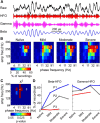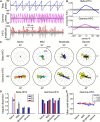Modulations in oscillatory frequency and coupling in globus pallidus with increasing parkinsonian severity
- PMID: 25878293
- PMCID: PMC4397612
- DOI: 10.1523/JNEUROSCI.4137-14.2015
Modulations in oscillatory frequency and coupling in globus pallidus with increasing parkinsonian severity
Abstract
While beta oscillations often occur within the parkinsonian basal ganglia, how these oscillations emerge from a naive state and change with disease severity is not clear. To address this question, a progressive, nonhuman primate model of Parkinson's disease was developed using staged injections of MPTP. Within each parkinsonian state (naive, mild, moderate, and severe), spontaneous local field potentials were recorded throughout the sensorimotor globus pallidus. In the naive state, beta oscillations (11-32 Hz) occurred in half of the recordings, indicating spontaneous beta oscillations in globus pallidus are not pathognomonic. Mild and moderate states were characterized by a narrower distribution of beta frequencies that shifted toward the 8-15 Hz range. Additionally, coupling between the phase of beta and the amplitude of high-frequency oscillations (256-362 Hz) emerged in the mild state and increased with severity. These findings provide a novel mechanistic framework to understand how progressive loss of dopamine translates into abnormal information processing in the pallidum through alterations in oscillatory activity. The results suggest that rather than the emergence of oscillatory activity in one frequency spectrum or the other, parkinsonian motor signs may relate more to the development of altered coupling across multiple frequency spectrums.
Keywords: Parkinson's disease; globus pallidus; local field potential; oscillations; phase-amplitude coupling.
Copyright © 2015 the authors 0270-6474/15/356231-10$15.00/0.
Figures






Similar articles
-
Parkinsonism and vigilance: alteration in neural oscillatory activity and phase-amplitude coupling in the basal ganglia and motor cortex.J Neurophysiol. 2017 Nov 1;118(5):2654-2669. doi: 10.1152/jn.00388.2017. Epub 2017 Aug 23. J Neurophysiol. 2017. PMID: 28835526 Free PMC article.
-
Physiological changes in the pallidum in a progressive model of Parkinson's disease: Are oscillations enough?Exp Neurol. 2016 May;279:187-196. doi: 10.1016/j.expneurol.2016.03.002. Epub 2016 Mar 2. Exp Neurol. 2016. PMID: 26946223 Free PMC article.
-
Subthalamo-pallidal interactions underlying parkinsonian neuronal oscillations in the primate basal ganglia.Eur J Neurosci. 2011 Nov;34(9):1470-84. doi: 10.1111/j.1460-9568.2011.07865.x. Eur J Neurosci. 2011. PMID: 22034978
-
Classification of pallidal oscillations with increasing parkinsonian severity.J Neurophysiol. 2015 Jul;114(1):209-18. doi: 10.1152/jn.00840.2014. Epub 2015 Apr 15. J Neurophysiol. 2015. PMID: 25878156 Free PMC article.
-
β oscillations in the cortico-basal ganglia loop during parkinsonism.Exp Neurol. 2013 Jul;245:52-9. doi: 10.1016/j.expneurol.2012.07.023. Epub 2012 Aug 23. Exp Neurol. 2013. PMID: 22921537 Review.
Cited by
-
Frequency and function in the basal ganglia: the origins of beta and gamma band activity.J Physiol. 2017 Jul 1;595(13):4525-4548. doi: 10.1113/JP273760. Epub 2017 Jun 5. J Physiol. 2017. PMID: 28334424 Free PMC article.
-
Pallidothalamic Circuit-Selective Manipulation Ameliorates Motor Symptoms in a Rat Model of Parkinsonian.J Neurosci. 2025 Mar 12;45(11):e0555242025. doi: 10.1523/JNEUROSCI.0555-24.2025. J Neurosci. 2025. PMID: 39837660
-
Cortical Phase-Amplitude Coupling in a Progressive Model of Parkinsonism in Nonhuman Primates.Cereb Cortex. 2019 Jan 1;29(1):167-177. doi: 10.1093/cercor/bhx314. Cereb Cortex. 2019. PMID: 29190329 Free PMC article.
-
Parkinsonism and vigilance: alteration in neural oscillatory activity and phase-amplitude coupling in the basal ganglia and motor cortex.J Neurophysiol. 2017 Nov 1;118(5):2654-2669. doi: 10.1152/jn.00388.2017. Epub 2017 Aug 23. J Neurophysiol. 2017. PMID: 28835526 Free PMC article.
-
Subthalamic deep brain stimulation reduces pathological information transmission to the thalamus in a rat model of parkinsonism.Front Neural Circuits. 2015 Jul 6;9:31. doi: 10.3389/fncir.2015.00031. eCollection 2015. Front Neural Circuits. 2015. PMID: 26217192 Free PMC article.
References
-
- Bergman H, Wichmann T, Karmon B, DeLong MR. The primate subthalamic nucleus. II. Neuronal activity in the MPTP model of parkinsonism. J Neurophysiol. 1994;72:507–520. - PubMed
-
- Bergman H, Raz A, Feingold A, Nini A, Nelken I, Hansel D, Ben-Pazi H, Reches A. Physiology of MPTP tremor. Mov Disord. 1998;13(Suppl 3):29–34. - PubMed
Publication types
MeSH terms
Grants and funding
LinkOut - more resources
Full Text Sources
Other Literature Sources
